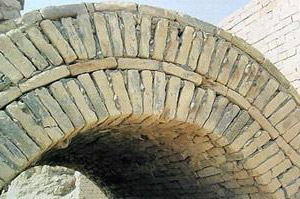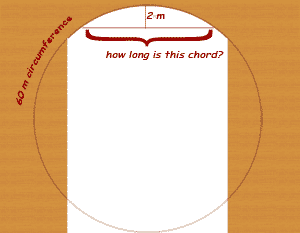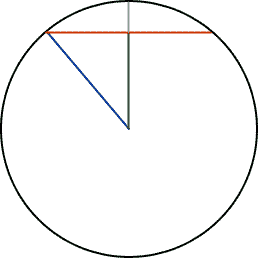| |||
| Math Central | Quandaries & Queries |
|
Question from Marleen, a teacher: The following problem and the solution were found on a Babylonian tablet dating from about 2600BC:
Such is the procedure. Modern day mathematicians have reasoned that the Babylonian Mathematician who solved this problem assumed that the value of Pi is 3. By explaining in detail how the Babylonian Mathematician must have solved this problem, justify the reasoning of the modern mathematicians. |
What a marvelous find, Marleen!
 I think they were building archways.
I think they were building archways.
Let's say you need to know the distance across an arch 2m below the top (we call that 2 m line the sagitta):

Babylonian Method:
Let's write this in using algebra, with C being the length of the circumference, x being the length of the chord and P being the perpendicular.
Thou double 2 and get 4
That's 2P.
Take 4 from 20, thou gettest 16
20 is C/3. So this is C/3 - 2P.
Square 16, thou gettest 256
That makes (C/3 - 2P)2.
Take 256 from 400, thou gettest 144
400 is (C/3)2. So we now have (C/3)2 - (C/3 - 2P)2.
Whence the square root of 144, 12 is the chord.
So they get x = sqrt( (C/3)2 - (C/3 - 2P)2 ). That's interesting. Let's compare that to what we get if we use modern mathematics. I'll draw another diagram:
 Modern Method:
Modern Method:
Now the radius is in blue and we know that the radius is the circumference divided by 2π: r = C/(2π). But the gray line's length is P, so the green vertical line (that's called the apothem) is r - P. That means its length is C/(2π) - P.
But we have a right triangle here, so the Pythagorean theorem applies. The length of the red chord is x, so the length of half the red chord (the length of the top of the triangle) is x/2.
Pythagorus tells us that
(x/2)2 = r2 - (r - P)2 = (C/(2π))2 - (C/(2π) - P )2.
If we multiply by 4 on both sides, we get:
x2 = (C/π)2 - (C/(π) - 2P)2.
Take the square root of both sides and we have:
x = sqrt( (C/π)2 - (C/π - 2P)2 ).
Comparison:
Now we can take the square root of both sides and compare our answer to the Babylonians':
Modern day: x = sqrt( (C/π)2 - (C/π - 2P)2 ).
Babylonians: x = sqrt( (C/3)2 - (C/3 - 2P)2 ).
So their equation is identical to ours, except that they use a 3 in place of π. Not too bad: it's within 5% of the real value of π.
Thanks for the fun,
Stephen La Rocque.
 |
||
Math Central is supported by the University of Regina and The Pacific Institute for the Mathematical Sciences.